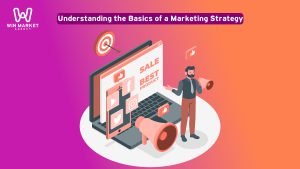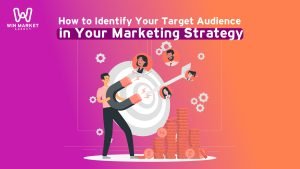In the accelerating and changing business world, building a successful marketing strategy is the basis for achieving sustainable growth and prosperity. This strategy requires careful analysis of the market, setting clear goals, and developing an effective implementation plan that combines innovation and technology. The challenge lies in the ability to adapt to rapid changes and take advantage of modern tools to reach the target audience effectively.
Marketing Strategy
Here, Win Market Agency plays a vital role, offering you the best solutions to build a successful marketing strategy that meets your unique needs and contributes to achieving your business goals. Thanks to its extensive experience and specialized team, the company ensures that your integrated marketing plan is compatible with the latest trends in the market, which enhances your chances of success and sustainable growth.
Understanding the Basics of a Marketing Strategy

Understanding the basics of marketing strategy is the key to achieving success in any business. A successful marketing strategy depends on a set of basic elements that include analysis, planning, implementation, and follow-up.
Here is a brief explanation of the basics of marketing strategy:
- Market analysis:
- External environment analysis: includes analysis of economic, social, technological, and political factors that may affect the market.
- Internal environment analysis: includes evaluating the strengths and weaknesses within the company such as resources, competencies, and organizational capabilities.
- Competitor analysis: involves studying direct and indirect competitors to identify opportunities and threats.
- Determine the target audience:
- Market segmentation: dividing the market into segments based on demographic, geographic, behavioral, and psychological characteristics.
- Selecting the target market: Identifying the segment or segments that the company can best serve.
- Develop buyer personas: Create representative personas of your target audience to better understand their needs and expectations.
- Determine marketing objectives:
- SMART Goals: Goals should be specific, measurable, achievable, relevant, and time-bound.
- Short and long-term goals: Set goals that achieve immediate improvements and others that aim for sustainable growth in the long term.
- Developing the marketing mix (4Ps):
- Product: Developing products or services that meet the needs of the target audience.
- Price: Determine a competitive pricing strategy that suits the market and target audience.
- Promotion: Identifying appropriate promotion and communication channels to reach the target audience.
- Place: Choosing distribution channels that ensure that products reach consumers effectively.
- Strategy implementation:
- Action Plan: Develop a detailed action plan that includes the activities and resources necessary to implement the strategy.
- Distribution of responsibilities: Defining roles and responsibilities within the team to ensure that plans are implemented efficiently.
- Monitoring and evaluation:
- Key Performance Indicators (KPIs): Define criteria to measure the success of the strategy.
- Continuous evaluation: Regularly review performance and make necessary adjustments to ensure goals are achieved.
- Adapt and improve:
- Responding to changes: willingness to adapt to changes in the market and external environment.
- Continuous innovation: Striving for continuous innovation and improvement to ensure that the company stays at the forefront.
Using these basics, any company can develop an effective marketing strategy that achieves its goals and ensures sustainable growth.
It may also benefit you: graphic-design
How to Identify Your Target Audience in Your Marketing Strategy

Defining your target audience is an essential step in building an effective marketing strategy. Target audiences are customers who are most likely to be interested in your products or services, and directing your marketing efforts toward them can increase the effectiveness of your marketing campaigns.
Here’s how to define your target audience:
- Market research:
- Market study: Conduct market research to understand the size and trends of the market.
- Competitor analysis: Look at who your competitors are targeting and how they interact with them.
- Study demographic data: such as age, gender, income, education, and geographic location.
- Analyze the current audience:
- Existing Clients: Who are your current clients? Analyze customer data to understand who is actually buying from you.
- Buying patterns: Find out what products are selling best and who is buying them.
- Market segmentation:
- Demographic segmentation: Segmenting the market based on demographic criteria such as age, gender, income, and marital status.
- Geographic segmentation: Segmenting a market based on geographic location such as city, region, or country.
- Psychological segmentation: analysis of psychological and behavioral patterns such as interests, values, and lifestyle.
- Behavioral segmentation: Segmenting the market based on consumer behavior such as frequency of usage, brand loyalty, and product benefits.
- Creating Buyer Personas:
- Defining representative personas: Build detailed personas that represent each segment of your target audience. These personas should include name, age, occupation, interests, challenges, and goals.
- Use factual data: Base your characters on actual data, not assumptions.
- Audience needs analysis:
- Understand the problems: Identify the problems your target audience is trying to solve.
- Identify solutions: Determine how your products or services can provide solutions to these problems.
- Select preferred media and channels:
- Digital Channels: Find out which digital channels (e.g. social media, email, blogs) your target audience prefers to use.
- Traditional advertising: Some audiences may prefer traditional advertising such as television, radio, or magazines.
- Test and modify the target audience:
- Test campaigns: Experiment with small marketing campaigns to test target audience engagement.
- Collect feedback: Get feedback from customers and users to improve your understanding of your audience.
- Analyze results: Use analysis tools to review campaign performance and adjust target audiences based on results.
- Continuous updating:
- Periodic review: Review your target audience periodically to ensure they continue to fit in with your products or services.
- Adapt to changes: Be prepared to update your strategy according to changes in the market and consumer behavior.
- These steps help you precisely define your target audience, which enhances the effectiveness of your marketing strategy.
Win Market ensures that you use the latest tools and technologies to analyze and identify your target audience, which helps you achieve the best results in your marketing campaigns.
Developing a Long-term Marketing Strategy for Sustainable Growth
Developing a long-term marketing strategy to achieve sustainable growth requires careful planning and ongoing commitment. The goal of this strategy is to build a strong and sustainable relationship with customers, and achieve sustainable growth for the company in the long term.
Here’s how to develop a long-term marketing strategy for sustainable growth:
- Market analysis and goal setting:
- Market Study: Analyze the market to understand the competitive environment, opportunities, and threats.
- Setting goals: Set clear, specific, measurable (SMART) goals for long-term growth.
- Determine the target audience:
- Customer Analysis: Identify and segment your target audience based on demographics, behavior, and needs.
- Create buyer personas: Use data to develop representative buyer personas to guide marketing efforts.
- Developing brand message and value:
- Defining values and benefits: Identify the unique value your brand offers compared to competitors.
- Message Development: Design a strong, engaging message that reflects the brand’s core values and targets the target audience.
- Choosing marketing channels:
- Digital Channels: Identify the most effective digital channels such as social media, email, and search engine optimization (SEO).
- Traditional Channels: There may also be a need to use traditional channels such as television, radio, and print advertising depending on the target audience.
- Developing a content strategy:
- Create valuable content: Focus on creating educational and entertaining content that engages the audience and builds trust.
- Diversity in content: Use a variety of content forms such as articles, videos, blogs, and podcasts.
- Improve customer experience:
- User Experience (UX): Work to improve user experience on all touchpoints including website and apps.
- Customer Service: Provide excellent customer service that supports building long-term customer relationships.
- Measurement and analysis:
- Data Analysis: Use data analysis tools to monitor performance and measure the impact of strategies.
- Modification and improvement: Continuously review and modify the strategy based on the results to improve performance and achieve goals.
- Adapting to changes:
- Keep up with developments: Follow new developments and trends in the market to keep your strategy relevant.
- Flexibility: Be flexible and prepare to adjust strategy based on changes in the market and customer needs.
Win Market helps you develop a long-term marketing strategy by providing multiple expertise in market analysis, content development, search engine optimization, and choosing the most appropriate marketing channels.
We ensure you achieve sustainable growth through careful planning and outstanding implementation of marketing strategies.
Marketing Strategy
Building a successful growth marketing strategy requires comprehensive planning and strategic thinking.
By analyzing the market, identifying the target audience, developing the brand message and value, and choosing the appropriate marketing channels, long-term and sustainable results can be achieved. Developing attractive content and improving customer experience are key factors that contribute to the success of the marketing strategy.
Win Market Agency offers you the best in building successful marketing strategies for growth through its deep experience and professional team.
We help you carefully analyze your market, clearly define your goals, and develop outstanding content that attracts your target audience.
We also provide you with the latest tools and technologies to improve the performance of your marketing campaigns and achieve sustainable growth for your company.
Contact us now to start your journey towards sustainable success.



